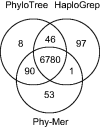Phy-Mer: a novel alignment-free and reference-independent mitochondrial haplogroup classifier
- PMID: 25505086
- PMCID: PMC4393525
- DOI: 10.1093/bioinformatics/btu825
Phy-Mer: a novel alignment-free and reference-independent mitochondrial haplogroup classifier
Abstract
Motivation: All current mitochondrial haplogroup classification tools require variants to be detected from an alignment with the reference sequence and to be properly named according to the canonical nomenclature standards for describing mitochondrial variants, before they can be compared with the haplogroup determining polymorphisms. With the emergence of high-throughput sequencing technologies and hence greater availability of mitochondrial genome sequences, there is a strong need for an automated haplogroup classification tool that is alignment-free and agnostic to reference sequence.
Results: We have developed a novel mitochondrial genome haplogroup-defining algorithm using a k-mer approach namely Phy-Mer. Phy-Mer performs equally well as the leading haplogroup classifier, HaploGrep, while avoiding the errors that may occur when preparing variants to required formats and notations. We have further expanded Phy-Mer functionality such that next-generation sequencing data can be used directly as input.
Availability and implementation: Phy-Mer is publicly available under the GNU Affero General Public License v3.0 on GitHub (https://github.com/danielnavarrogomez/phy-mer).
Contact: Xiaowu_Gai@meei.harvard.edu
Supplementary information: Supplementary data are available at Bioinformatics online.
© The Author 2014. Published by Oxford University Press. All rights reserved. For Permissions, please e-mail: journals.permissions@oup.com.
Figures
Similar articles
-
HAPLOFIND: a new method for high-throughput mtDNA haplogroup assignment.Hum Mutat. 2013 Sep;34(9):1189-94. doi: 10.1002/humu.22356. Epub 2013 Jun 12. Hum Mutat. 2013. PMID: 23696374
-
ACE: accurate correction of errors using K-mer tries.Bioinformatics. 2015 Oct 1;31(19):3216-8. doi: 10.1093/bioinformatics/btv332. Epub 2015 May 28. Bioinformatics. 2015. PMID: 26026137
-
HaploGrep 2: mitochondrial haplogroup classification in the era of high-throughput sequencing.Nucleic Acids Res. 2016 Jul 8;44(W1):W58-63. doi: 10.1093/nar/gkw233. Epub 2016 Apr 15. Nucleic Acids Res. 2016. PMID: 27084951 Free PMC article.
-
Next-generation sequencing for mitochondrial disorders.Br J Pharmacol. 2014 Apr;171(8):1837-53. doi: 10.1111/bph.12469. Br J Pharmacol. 2014. PMID: 24138576 Free PMC article. Review.
-
K-Mer-Based Genome Size Estimation in Theory and Practice.Methods Mol Biol. 2023;2672:79-113. doi: 10.1007/978-1-0716-3226-0_4. Methods Mol Biol. 2023. PMID: 37335470 Review.
Cited by
-
Systems Genetic Identification of Mitochondrion-Associated Alzheimer's Disease Genes and Implications for Disease Risk Prediction.Biomedicines. 2022 Jul 24;10(8):1782. doi: 10.3390/biomedicines10081782. Biomedicines. 2022. PMID: 35892682 Free PMC article.
-
Landscape of Mitochondria Genome and Clinical Outcomes in Stage 1 Lung Adenocarcinoma.Cancers (Basel). 2020 Mar 23;12(3):755. doi: 10.3390/cancers12030755. Cancers (Basel). 2020. PMID: 32210009 Free PMC article.
-
HaploCart: Human mtDNA haplogroup classification using a pangenomic reference graph.PLoS Comput Biol. 2023 Jun 7;19(6):e1011148. doi: 10.1371/journal.pcbi.1011148. eCollection 2023 Jun. PLoS Comput Biol. 2023. PMID: 37285390 Free PMC article.
-
"Mitochondrial Toolbox" - A Review of Online Resources to Explore Mitochondrial Genomics.Front Genet. 2020 May 8;11:439. doi: 10.3389/fgene.2020.00439. eCollection 2020. Front Genet. 2020. PMID: 32457801 Free PMC article. Review.
-
A benchmarking of human mitochondrial DNA haplogroup classifiers from whole-genome and whole-exome sequence data.Sci Rep. 2021 Oct 15;11(1):20510. doi: 10.1038/s41598-021-99895-5. Sci Rep. 2021. PMID: 34654896 Free PMC article.
References
-
- Anderson S., et al. (1981) Sequence and organization of the human mitochondrial genome. Nature, 290, 457–465. - PubMed
-
- Andrews R.M., et al. (1999) Reanalysis and revision of the Cambridge reference sequence for human mitochondrial DNA. Nat. Genet., 23, 147. - PubMed
-
- Bandelt H.J., Parson W. (2008) Consistent treatment of length variants in the human mtDNA control region: a reappraisal. Int. J. Legal Med., 122, 11–21. - PubMed
-
- Bandelt H.J., et al. (2012) Haplogrouping mitochondrial DNA sequences in Legal Medicine/Forensic Genetics. Int. J. Legal Med ., 126, 901–916. - PubMed
Publication types
MeSH terms
Substances
Grants and funding
LinkOut - more resources
Full Text Sources
Other Literature Sources
Miscellaneous


